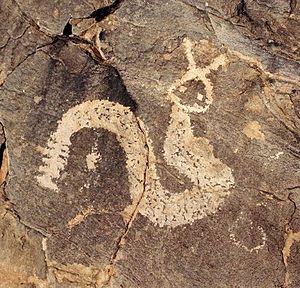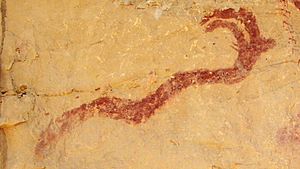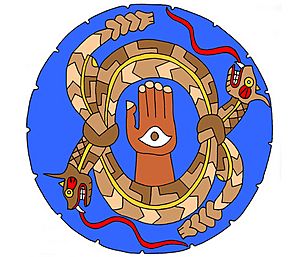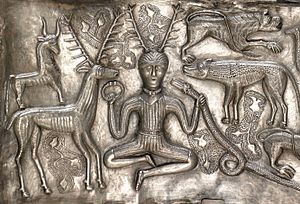Horned Serpent facts for kids

The Horned Serpent is a special creature found in the stories of many Native American peoples. These stories often connect the Horned Serpent with water, rain, lightning, and thunder. It was a very important symbol in the Southeastern Ceremonial Complex, which was a major part of ancient Native American traditions in the southeastern United States.
Horned serpents also appear in old stories from Europe and the Near East.
Contents
Horned Serpents in Native American Stories

Horned serpents are a big part of the stories passed down by many Native American cultures. You can find these tales especially in the Southeastern Woodlands and Great Lakes regions.
Muscogee Creek Stories
The Muscogee Creek people have stories about a Horned Serpent and a Tie-Snake. In their language, the Muscogee Creek language, it's called estakwvnayv. Sometimes people think they are the same creature. Other times, they are seen as similar but different, with the Horned Serpent being much larger.
For the Muscogee people, the Horned Serpent is a water snake. It has shiny, crystal-like scales and a big crystal on its forehead. Both the scales and the crystal were believed to have special powers for telling the future. Its horns, called chitto gab-by, were used in medicine.
One Muscogee Creek elder, Jackson Lewis, said that this snake lives in the water. He said it has horns like a deer and is not a bad snake. It doesn't hurt people but seems to have a special power over animals used for hunting. In stories, the Horned Serpent loved to eat sumac, a plant called Rhus glabra.
Alabama and Yuchi Beliefs
The Alabama people call the Horned Serpent tcinto såktco, meaning "crawfish snake." They sort these snakes into four groups based on the color of their horns: blue, red, white, or yellow.
The Yuchi people even made models of the Horned Serpent. As recently as 1905, they made one from deerhide, painted blue with yellow antlers. The Yuchi Big Turtle Dance honors the Horned Serpent's spirit. This spirit was linked to storms, thunder, lightning, sickness, and rainbows.
Cherokee Uktena
Among the Cherokee people, a Horned Serpent is known as an uktena. An expert named James Mooney described it like this:
The Uktena is a giant snake, as thick as a tree trunk. It has horns on its head and a bright, shining crest like a diamond on its forehead. Its scales glow like sparks of fire. It has rings or spots of color all along its body. You can only hurt it by shooting it in the seventh spot from its head. That's where its heart and life are.
The glowing diamond is called Ulun'suti, which means "Transparent." If someone can get this diamond, they could become the greatest magic worker of the tribe. But trying to get it is very dangerous. If the Uktena sees you, its bright light will make you so confused that you run towards the snake instead of away. Also, the Uktena's breath is so deadly that no living thing can survive breathing even a tiny bit of its foul air. Even seeing the Uktena asleep means death, not for the hunter, but for their family.
Sioux Unhcegila
According to Sioux beliefs, the Unhcegila (Ųȟcéǧila) were dangerous water monsters. They lived in ancient times and came in many shapes. Eventually, the Thunderbirds destroyed them all. Only small creatures like snakes and lizards were left. This belief might have come from finding dinosaur fossils in Sioux lands. The Thunderbird stories might have been inspired by finding pterosaur skeletons.
Other Names for the Horned Serpent
- Sisiutl— Kwakwaka'wakw
- Awanyu—Tewa
- Djodi'kwado'—Iroquois
- Misi-kinepikw ("great snake")—Cree
- Msi-kinepikwa ("great snake")—Shawnee
- Misi-ginebig ("great snake")—Oji-Cree
- Mishi-ginebig ("great snake")—Ojibwe
- Pita-skog ("great snake")—Abenaki
- Sinti' Isht-Ahollo'—Chickasaw
- Sinti Lapitta—Choctaw
- Unktehi or Unktehila—Dakota
- ʔU·lahkaha·p ("white snake")—Natchez
- Uktena—Aniyunwiya
- mazacoatl - Nahuatl
Horned Serpents Around the World
In Europe
Celtic Art
The ram-horned serpent was a common symbol in ancient Europe, especially before and during the Roman period. It appears three times on the Gundestrup cauldron, a famous ancient pot. In ancient Gaul (now France), it was often seen with the horned god Cernunnos. This pairing can be found as early as the fourth century BC in Northern Italy. There, a huge antlered figure with neck rings and a serpent was carved into rocks in Val Camonica.
Some ancient artworks show Cernunnos with two horned snakes wrapped around his body. These snakes are shown eating from bowls of fruit and grain in the god's lap. Another carving shows a goddess holding a "horn of plenty" (cornucopia) and a pomegranate, with a horned serpent eating from a bowl.
Experts like Miranda Green believe these snakes show the god's peaceful nature. They suggest he was connected to nature, fruitfulness, and rebirth. Other gods were also sometimes shown with ram-horned serpents. These snakes, along with regular snakes, sometimes appeared with the solar wheel, which was a symbol of the sun or sky god.
Northern and Central Europe
Stories about horned serpents are also found in the folklores of Northern and Central Europe. For example, there are many tales about the Lindworm, a dragon-like creature. Icelandic folklore tells of the Lagarfljót Worm, a serpent in a lake. In Southern Sweden, there are stories of a huge water snake called Storsjöodjuret. Seeing this snake was said to be deadly, similar to the basilisk creature.
Greek Mythology
In Greek mythology, the cerastes is a snake with either two large ram-like horns or four pairs of smaller horns. An ancient writer named Isidore of Seville said it hunted by burying itself in the sand. It would leave its horns visible to attract other creatures, then attack them.
In Mesopotamia
In ancient Mesopotamian stories, the god Ningishzida is sometimes shown as a serpent with horns. In other pictures, he looks human but is with bashmu, mushussu, and ushumgal. These are three types of horned snakes in Akkadian mythology. Ningishzida shares the title ushumgal, meaning "great serpent," with other Mesopotamian gods.
See also
- Avanyu
- Amaru
- Chinese dragon
- Coi Coi-Vilu
- Feathered Serpent (deity)
- Kukulcan
- Lindworm
- Moñái
- Nāga
- Ophiotaurus
- Quetzalcoatl
- Sidewinder rattlesnake of the American Southwest, a living "horned serpent"
- Kitchi-at'Husis and Weewilmekq
- Tciptckaam
- Horned deity
- Piasa Bird, Alton, Illinois
- Sea goat
|




